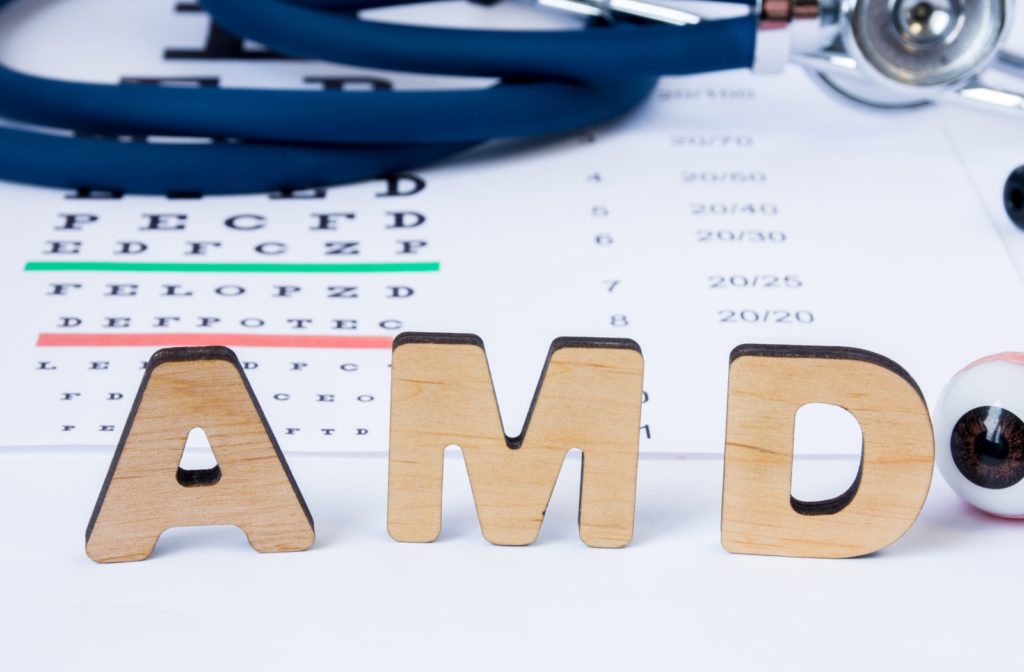Age-Related Macular Degeneration
You may have heard about age-related macular degeneration (AMD); after all, it is the leading cause of vision loss in adults over 65. AMD progresses gradually with very few early warning symptoms, and typically affects adults over 50.
This condition occurs when the macula starts to deteriorate as part of the normal ageing process.
The macula is located at the centre of your retina, and its main function is to provide clear and precise detail in your central vision. As the macula deteriorates, central vision becomes blurry, black spots may appear in the visual field, and colour vision fades.
These symptoms may only be apparent after the disease has caused damage. Central vision is crucial for daily activities like driving or reading, so diagnosing and managing AMD in its early stages is essential.
Early-stage AMD may not require treatment, but your optometrist will closely monitor your visual health and offer options for treatment if the condition worsens. More advanced cases of AMD may be treated with anti-VEGF drugs or photodynamic therapy (PDT).
AMD has two variations:
- Dry AMD: Dry AMD occurs as the macula thins slowly over time, eventually causing vision problems.
- Wet AMD: If dry AMD is left untreated, it can develop into wet macular degeneration. The onset of wet AMD develops more quickly, and is the cause of approximately 90% of AMD-related blindness.
Wet AMD occurs when abnormal blood vessels form under the retina, resulting in fluid leakage from the macula. Wet AMD is a medical emergency that often results in irreversible vision loss, and it must be treated by a medical professional.
Risk Factors for AMD
Here are a few risk factors for age-related macular degeneration:
- AMD in the family’s medical history
- Smoking cigarettes
- Eating a diet high in saturated fat
- Obesity
- Hypertension (high blood pressure)
- Adults over 50
- Heart disease
- High cholesterol
How Does My Optometrist Test for AMD?
An optometrist can diagnose age-related macular degeneration by reviewing your medical and family history, and performing a series of tests during your routine eye exam:
- Eye Exam: Your eye doctor uses drops to dilate your eyes, then uses a special instrument to examine their anterior. They look closely for drusen— yellow deposits forming underneath the retina.
- Testing central vision: Your eye doctor may use an Amsler grid to look for problems in the central vision. Patients with AMD may see distorted, blurred or broken lines on a usually straight-lined Amsler grid.
- Fluorescein angiography: This test consists of a coloured dye that highlights the blood vessels in your eyes, and a specialized camera to capture the images. These images will show any retinal changes or abnormal blood vessels.
- Optical coherence tomography (OCT): OCT is a non-invasive imager that creates a detailed map of the retina, helping to identify areas of thinning or swelling.

The Amsler Grid
At first glance, an Amsler grid simply appears to be a square containing a grid pattern with a dot in the middle. But this specialized square is so much more than meets the eye!
The Amsler grid is a testing tool that can be used on a daily basis to help find blurred, distorted or blank spots in your visual field. Vision loss from AMD develops slowly, and it can be difficult to determine any changes in sight.
Here are a few steps to help you use the Amsler grid on a daily basis:
- Make sure you’re in a room with good lighting.
- Wearing your usual eyewear, hold the grid at the same distance you would when reading.
- Cover one eye.
- Use your uncovered eye to look directly and stay focused on the dot in the centre.
- While continuing to look at the centre dot, be aware of your side vision. Notice if the grid lines still appear straight or if any lines appear distorted, blurry, waved, dark, or blank.
- Repeat these steps with your other eye.
Contact your eye care team right away if you notice any anomalies in the visual field while conducting your daily Amsler grid test. Your optometrist will be able to provide insights and treatment options to help slow vision loss.
How to Slow Vision Loss Related to AMD
Being diagnosed with age-related macular degeneration can be a life-changing and confusing event. A compassionate eye care team can provide treatment and support throughout your journey with this eye condition.
AMD is a common condition in older adults, and you are not alone!
Here are a few additional steps you can take to help improve quality of life and slow vision loss after an AMD diagnosis:
- Quit smoking: Contact your doctor for assistance with quitting smoking.
- Eat a healthier diet: Foods high in antioxidants, zinc, healthy fats, omega-3 fatty acids, and protein can contribute to better eye health.
- Manage medical conditions: Closely follow your doctor’s care instructions and take the necessary medications.
- Exercise regularly: Increase your amount of daily exercise.
- Keep up with routine eye exams: Follow your optometrist’s recommended schedule for check-ups.
- Use an Amsler grid daily: Self-assess your vision and contact your optometrist right away if you notice any changes.
We’re Here to Help
Legacy Eye Care is an experienced and compassionate practice filled with incredible people, and we’re available to help whenever you need us.
If you have questions about vision loss related to AMD, want to learn how to use an Amsler grid, or feel it’s time to book a comprehensive eye exam, give us a call today.



